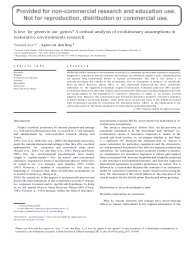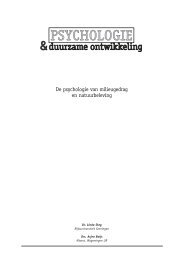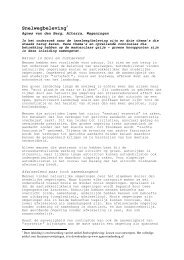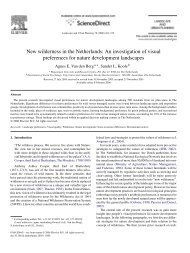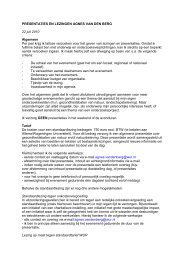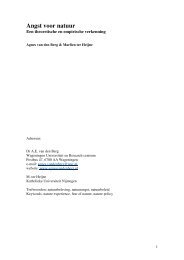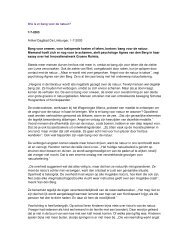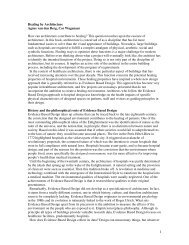healing environments in radiotherapy - Agnes van den Berg
healing environments in radiotherapy - Agnes van den Berg
healing environments in radiotherapy - Agnes van den Berg
You also want an ePaper? Increase the reach of your titles
YUMPU automatically turns print PDFs into web optimized ePapers that Google loves.
Heal<strong>in</strong>g Environments <strong>in</strong> Radiotherapy Project Report<br />
In the beg<strong>in</strong>n<strong>in</strong>g of the twentieth century, the tradition to locate hospitals <strong>in</strong> natural <strong>environments</strong><br />
broke off. Due to a revolution <strong>in</strong> medic<strong>in</strong>e and technology comb<strong>in</strong>ed with the emergence of<br />
modernist design styles the environmental qualities of hospitals became neglected (Van <strong>den</strong> <strong>Berg</strong> &<br />
Wagenaar, 2006). In the late 1970s, <strong>in</strong>terest <strong>in</strong> the effects of the environment on <strong>heal<strong>in</strong>g</strong> and health<br />
outcomes was renewed. The US non-profit organization Planetree designed a model which <strong>in</strong>dicated<br />
healthcare design should provide possibilities to connect with nature. Heal<strong>in</strong>g gar<strong>den</strong>s, fish tanks,<br />
waterfalls and gentle sounds were provided to connect patients, family and staff with the relax<strong>in</strong>g<br />
and <strong>heal<strong>in</strong>g</strong> aspects of nature. (Van <strong>den</strong> <strong>Berg</strong>, 2005, p. 9-12). Currently, the concepts of <strong>heal<strong>in</strong>g</strong><br />
environment and evi<strong>den</strong>ce based design are <strong>in</strong>creas<strong>in</strong>gly implemented <strong>in</strong> hospitals all over the world.<br />
Heal<strong>in</strong>g environment concepts are be<strong>in</strong>g implemented frequently <strong>in</strong> the United States, are becom<strong>in</strong>g<br />
common <strong>in</strong> Swe<strong>den</strong> and Denmark, as well as <strong>in</strong> Canada, and also <strong>in</strong>creas<strong>in</strong>gly <strong>in</strong> Japan and other<br />
Asian countries like S<strong>in</strong>gapore. The Netherlands is also among the countries that have recently begun<br />
to implement pr<strong>in</strong>ciples of <strong>heal<strong>in</strong>g</strong> environment (Ulrich, 2009).<br />
© hub<strong>in</strong>et.com<br />
1.3 Evi<strong>den</strong>ce-based design<br />
Until recently, efforts to design <strong>heal<strong>in</strong>g</strong> <strong>environments</strong> <strong>in</strong> healthcare were mostly based on common<br />
sense and philosophical notions of healthcare providers. When professional awareness of the role of<br />
the environment on the <strong>heal<strong>in</strong>g</strong> process <strong>in</strong>creased, scientific evi<strong>den</strong>ce of the relationship between<br />
health and environment was called for. Ulrich (1984) was the first to produce scientific evi<strong>den</strong>ce for<br />
health impacts of <strong>heal<strong>in</strong>g</strong> <strong>environments</strong>. His research showed that surgery patients who were able to<br />
view nature from their rooms had shorter postoperative hospital stays, and suffered fewer occasions<br />
of be<strong>in</strong>g upset or ‘down’, and less post-surgery complications such as persistent headaches or<br />
nausea. Furthermore, patients who did not have natural views needed stronger pa<strong>in</strong> relief drugs than<br />
patients with a view of nature. Such f<strong>in</strong>d<strong>in</strong>gs call for architecture and medic<strong>in</strong>e to unite, to develop<br />
research agendas to explore the <strong>in</strong>teraction of science and design <strong>in</strong> order to move <strong>in</strong>to new<br />
directions <strong>in</strong> the design of health care facilities (UMC Gron<strong>in</strong>gen, 2009).<br />
This scientific approach to design<strong>in</strong>g <strong>heal<strong>in</strong>g</strong> <strong>environments</strong> is called evi<strong>den</strong>ce-based design, as an<br />
architectural parallel to evi<strong>den</strong>ce-based medic<strong>in</strong>e (Van <strong>den</strong> <strong>Berg</strong>, 2005, p. 13). The Center for Health<br />
Design describes evi<strong>den</strong>ce-based design as “the process of bas<strong>in</strong>g decisions about the built<br />
environment on credible research to achieve the best possible outcomes” (2009). Hereby the goal “is<br />
to create hospitals that actually help patients recover and be safer, and help staff do their jobs<br />
better” (Ulrich et al., 2004, p. 26). Evi<strong>den</strong>ce-based design can therefore be seen as scientifically<br />
grounded practical guidel<strong>in</strong>es to creat<strong>in</strong>g a <strong>heal<strong>in</strong>g</strong> environment.<br />
1.4 Project goals<br />
The <strong>radiotherapy</strong> department at the target hospital is currently situated <strong>in</strong> a basement with little<br />
access to daylight and fresh air. The commissioner wished to ga<strong>in</strong> <strong>in</strong>sights <strong>in</strong>to elements of <strong>heal<strong>in</strong>g</strong><br />
<strong>environments</strong> specifically for cancer patients, <strong>in</strong> order to be able to make <strong>in</strong>formed decisions about<br />
4



